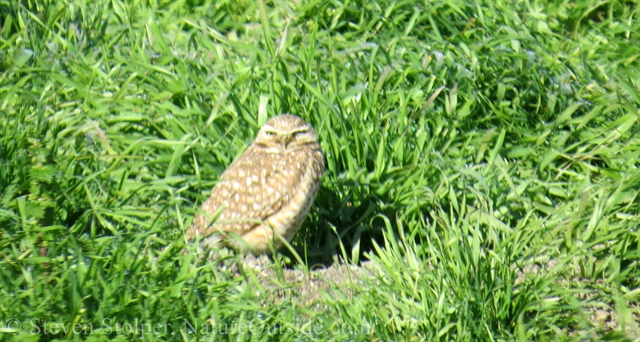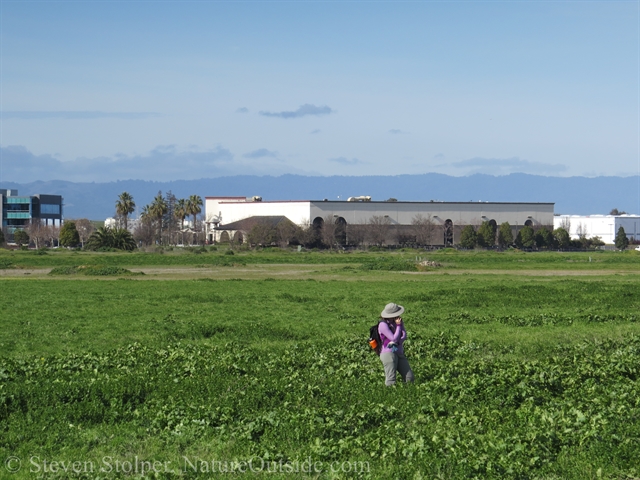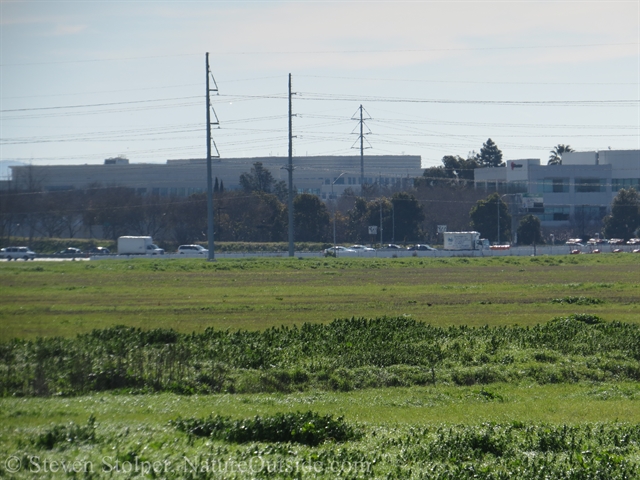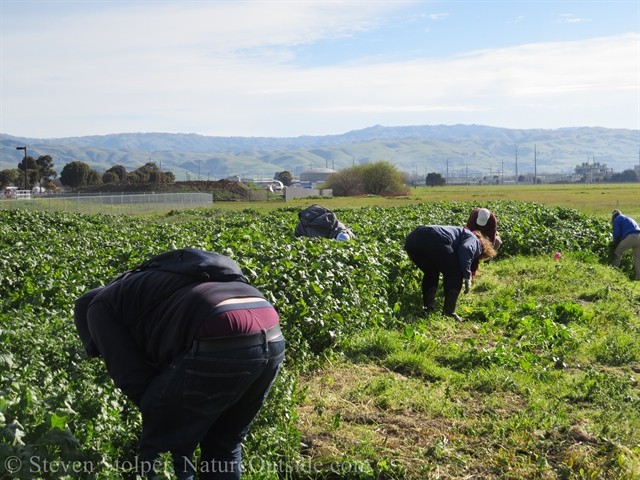
I didn’t expect it would be so cold.
I yank my fleece over my head. My long sleeve polypro shirt isn’t enough to keep me warm in the chill morning air.
After days of winter rain, it’s a glorious morning. Rivers of blue sky flow between high hazy clouds. The calm air betrays no hint of breeze. Birds practice their spring songs as we march onto the grassy field.
Owl in a Day’s Work
I have a few hours to spare on a Saturday morning. So I volunteer to do some habitat restoration for the Western Burrowing Owl (Athene cunicularia). The outing is run jointly by the San Francisco Bay Bird Observatory and the Santa Clara Valley Audubon Society.
Our job: Remove tall invasive plants from the low grassland where the owls nest and raise their young.
The Western Burrowing Owl
The Western Burrowing Owl is a grassland specialist. It lives in open areas with short vegetation and bare ground.
The owls eat small mammals, insects, and anything else they can catch.
What makes these birds amazing is that the live underground! Despite their name, the owls don’t actually burrow. They commandeer the burrows of fossorial mammals like ground squirrels or prairie dogs. They use the underground chambers to nest and roost. And unlike other owls, they’re diurnal (active during the daytime). So you have a good chance to see them, if you know what to look for.
Unfortunately, populations of Burrowing Owls are in steep decline. They’re protected by the Migratory Bird Treaty Act in the United States and Mexico. But the situation is dire. They’re listed as Endangered in Canada and Threatened in Mexico. They are considered by the U.S. Fish and Wildlife Service to be a Bird of Conservation Concern at the national level. Burrowing Owls are listed as Endangered in Minnesota, Threatened in Colorado, and as a Species of Concern in California, Montana, Oklahoma, Oregon, Utah, Washington, and Wyoming.
As you can imagine, habitat loss plays a leading role in their decline. Grasslands are being converted to agriculture or paved-over for urban development. And the habitat that remains is being degraded so that their home builders (burrowing mammals) and their prey are disappearing. Add habitat fragmentation, predation, illegal shooting, pesticides and other contaminants, and you can see why the owl’s numbers are plummeting.
It’s a Personal Problem
When I moved to the San Francisco Bay Area, I lived among grassy fields that were prime habitat for the owls. Slowly and surely people changed this landscape. High-rise apartments and office buildings now stand on fields that would have been great habitat for Burrowing Owls.
The San Francisco Bay Area is historically one of four primary Burrowing Owl nesting areas in California. And the year-over-year decline of these birds troubles my heart.
Humans Lend a Hand
Not far from where I live is the City of San José’s wastewater treatment facility. I heard that they used chlorine to treat the water. So development was prohibited on land nearby the facility. This created ideal habitat for the owls.
My understanding is that the treatment plant no longer uses chlorine, and the land has been re-zoned to permit development. But for the moment, approximately 200 acres of land are set aside for the Burrowing Owl.
Our job is to remove the tall invasive plants that are growing in the grassland. These plants obstruct the owl’s view when it stands beside the entrance to its burrow. This makes the land less desirable for nest sites, and makes the owls and their chicks more vulnerable to predators.
So we trudge out to raised mounds on the field to pull weeds. Most of the burrows are excavated by ground squirrels. But there are a few man-made burrows as well.

The empty field stands amidst light industrial buildings. In all directions half-completed office buildings are under construction.

A major highway runs along one side of the field. Tens of thousands of commuters pass the field each day, unaware of the owls.
It’s not hard work. The plants are young and the ground is moist. So a light tug will yank them up, roots and all. We pull stinging nettle, mustards, and other weeds. My leather gloves protect my hands from the nettle’s stingers. I toy with the idea of harvesting some for dinner. Stinging nettle is delicious and nutritious, when properly prepared.

We pull stinging nettle, mustards, and other invasive plants that obstruct the owl’s view.
Give it Owl You Got
After two hours, our group makes a noticeable impact. Many hands make light work!
Nearby, one of the owls stands beside its den. It’s keeping an eye on us humans who give a hoot!

A Western Burrowing Owl eyes us as we pull weeds.
If you get the chance, volunteer with one of the organizations mentioned above. It’s a great way to make a difference. And you don’t need special skills. It’s loads of fun!
What nature-related volunteer work do you do? Let me know in the comments below.
Related Articles on NatureOutside
Where do Birds go When it Rains?
Owl Class – The Harry Potter School of Bushcraft
Acorn Woodpecker – This Bird is Nuts! (Video)
For fun facts and useful tips, join the free Bushcraft Newsletter.



Leave a Comment